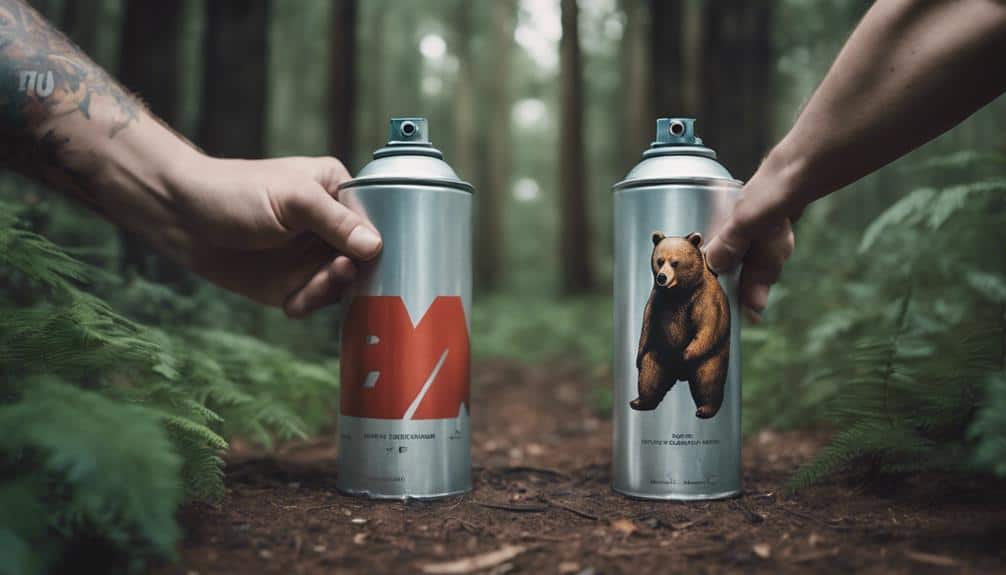When you’re trying to pick between
bear spray and
animal deterrent sprays, here’s what you really need to know.
Bear spray packs a punch with a
higher concentration of capsaicin, hitting up to 40 feet—perfect for those “back off, big buddy!” moments. On the flip side, animal deterrent sprays are for smaller critters like raccoons or dogs, with a shorter range and less oomph. Plus, bear spray is
tightly regulated by the EPA, making it super reliable, while
animal deterrents might not always meet the same standards. Curious about which one fits your needs best? Let’s just say the choice is wild.
Purpose and Usage
Bear spray and
animal deterrent sprays serve different purposes and are used in varying scenarios to guarantee
personal safety in wildlife encounters.
Imagine you’re hiking in bear country. Suddenly, a massive grizzly appears, and your heart races. That’s when
bear spray becomes your best friend. Specifically designed for deterring
aggressive bears, it contains a higher concentration of the active ingredient
capsaicin, which causes temporary blindness and extreme discomfort, giving you a chance to escape.
On the other hand, animal deterrent sprays cater to various
wildlife threats. Maybe you’re facing a pesky raccoon or an aggressive dog. These sprays usually have a lower concentration of capsaicin, making them less potent than bear spray. They’re more about personal defense in urban or less wild settings.
Bear spray boasts an
effective range of 30-40 feet, creating a wide mist that covers more area—perfect for large, charging animals like bears. In contrast, animal deterrent sprays often have a shorter range, requiring you to be closer to the threat.
Bear spray also operates under stricter legal regulations, being
EPA-registered specifically for use against bears, ensuring its reliability.
Composition and Strength
When comparing
bear spray to
animal deterrent sprays, one key difference lies in their
composition and strength.
Imagine you’re hiking and suddenly face a bear—scary, right? Bear spray, packed with
2% oleoresin capsaicin, is your best friend here. This spicy stuff is way more potent than what’s in standard animal deterrent sprays, which usually have 1% or less.
Bear spray is like a superhero mist designed for
broader coverage. It creates a wide cloud that can reach 30-40 feet, effectively
incapacitating a large bear. On the other hand, animal deterrent sprays shoot a narrow stream, only effective up to 10-12 feet. If a big dog or other smaller critter’s your problem, these sprays work fine, but against a bear? Not so much.
Bear spray’s strength is no joke, and it’s
regulated by the EPA to guarantee it’s up to the task. That means you can trust it to work when you need it most. Animal deterrent sprays, however, don’t always have the same rigorous oversight.
Legal Regulations
Maneuvering the
legal landscape for using
bear spray and
animal deterrent sprays can be tricky, as regulations vary widely by region. The Environmental Protection Agency (EPA) regulates bear spray, ensuring it meets specific standards for effectiveness and humane use. On the other hand, animal deterrent sprays mightn’t have the same level of federal oversight, making it essential to understand your
local regulations.
When it comes to
purchasing restrictions, bear spray typically requires you to be 18 or older, similar to many animal deterrent sprays. However, state laws can differ, so you’ve got to check the specifics where you live.
Misuse of bear spray can land you in hot water with
serious legal consequences, ranging from misdemeanors to felonies. In contrast, animal deterrent sprays mightn’t carry such severe legal implications, but don’t assume you can spray willy-nilly without repercussions.
Bear spray is intended for use only against bears and other large animals. Spraying a human? That’s likely illegal and could get you into a heap of trouble. Animal deterrent sprays may have broader applications, depending on local laws. Knowing your local regulations is key to staying on the right side of the law and using these sprays responsibly.
Frequently Asked Questions
What Is the Difference Between Dog Spray and Bear Spray?
Dog spray effectiveness varies due to lower oleoresin capsaicin, targeting close encounters. Bear spray ingredients are stronger, offering broader coverage for wildlife safety. For outdoor adventures, understand animal behavior and use proper spray application techniques for ideal protection.
What Is the Difference Between Bear Spray and OC Spray?
Bear spray’s effectiveness against large animals comes from its higher oleoresin capsicum concentration. OC sprays have lower potency. Bear spray’s range and mist application techniques differ. Legal regulations and safety precautions vary, impacting usage scenarios and environmental impact.
Is Bear Spray Stronger Than Coyote Spray?
Yes, bear spray is stronger than coyote spray. It has higher oleoresin capsicum concentration, broader range, and is more effective in wildlife encounters. Always check regulations, consider environmental impact, and follow safety precautions for personal protection.
Why Not Use Bear Spray?
You shouldn’t use bear spray due to safety concerns, legal restrictions, and its wide mist effectiveness range. Follow usage guidelines, consider alternative methods, and think about personal experiences. Proper storage recommendations and application techniques are essential for wildlife encounters.






